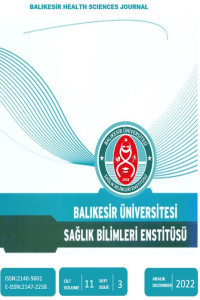DENTİGERÖZ KİSTE BAĞLI HİPOESTEZİ: BİR OLGU SUNUMU
Bu çalışmanın amacı mandibulada dentigeröz kiste bağlı oluşan hipoestezi olgusunun klinik ve radyografik bulgularını değerlendirmektir. 60 yaşında erkek hasta sağ alt dudağında yaklaşık bir aydır bulunan uyuşukluk şikayetiyle kliniğimize başvurdu. Hastadan panoramik radyografi ve dental volumetrik tomografi alındı. Radyografik incelemede belirlenen gömülü sağ mandibular üçüncü molar diş ve dişi çevreleyen lezyon çıkartılarak hastanın tedavisi yapıldı. Panoramik radyografta sağ mandibulada gömülü üçüncü molar dişin folikül genişliği yaklaşık 5 mm olarak belirlendi. Dental volumetrik tomografi, gömülü dişin kuronuyla ilişkili düzgün sınırlı uniloküler radyolüsensiyi, mandibular kanal, diş ve kist arasındaki yakın anatomik ilişkiyi gösterdi. Histopatolojik incelemede lezyona dentigeröz kist tanısı koyuldu. Postoperatif 6. ayda hipoestezi şikayeti kayboldu. Mandibular kanala yakın anatomik lokalizasyon gösteren gömülü dişlerin hipoestezi sebebi olabileceği düşünülmelidir.
Anahtar Kelimeler:
Dentigeröz Kist, Hipoestezi
HYPOESTHESIA DUE TO A DENTIGEROUS CYST: A CASE REPORT
The aim of this study was to evaluate the clinical and radiological findings of a hypoesthesia case due to dentigerous cyst in mandible. 60-year-old male patient referred to our clinic with the complaint of numbness in the right lower lip for a month. Panoramic radiography and cone beam computed tomography were performed. Patient was treated by the surgical excision of the radiologically determined impacted right mandibular third molar teeth and the surrounding lesion. Panoramic radiograph revealed that the follicular space size of the impacted third molar teeth in right mandible was about 5 mm. Cone beam computed tomography confirmed a well-defined, unilocular radiolucency associated with the crown of the impacted tooth, and a close anatomical relationship between the tooth and the mandibular canal, as well as between the cyst and the mandibular canal. Histopathologic evaluation revealed dentigerous cyst. After the treatment, hypoesthesia is resolved within 6 months. The presence of impacted teeth represented close anatomical localization to mandibular canal should be thought as a reason of hypoesthesia.
Keywords:
Dentigerous cyst, Hypoesthesia,
___
- 1. White SC, Pharoah MJ: Oral Radiology Principles and Interpretation, 5th ed, s. 384-400, St. Louis, (2004).
- 2. Regezi AJ, Sciubba JJ, Jordan RCK: Oral Pathology: Clinical Pathologic Correlations, 5th ed, s.52-4, St. Louis, Saunders, (2008).
- 3. Kumar N, Rama Devi M, Vanaki S, Puranik S. Dentigerous cyst occurring in maxilla associated with supernumerary tooth showing cholesterol clefts—a case report. Int J Dent Clin 2010; 2: 39-42.
- 4. Yaltkaya K: Nörolojik Muayene, 2. Baskı, s.121-5, Palme Yayıncılık, Ankara, (2005).
- 5. Hıllerup S. Iatrogenic injury to the inferior alveolar nerve: etiology, signs and symptoms, and observations on recovery. Int. J. Oral Maxillofac. Surg. 2008; 37: 704-9.
- 6. Moon S, Jong Lee S, Kim E. Hypoesthesia after IAN block anesthesia with lidocaine: management of mild to moderate nerve injury. Restor Dent Endod 2012; 37(4): 232-5.
- 7. Scolozzi P, Lombardi T, Jaques B et al. Successful inferior alveolar nerve decompression for dysesthesia following endodontic treatment: Report of 4 cases treated by mandibular sagittal osteotomy. Oral Surg Oral Med Oral Pathol Oral Radiol Endod 2004; 97: 625-31
- 8. Baykul T, Koçer G, Çına Aksoy M, ve ark. Isparta ve çevresinde görülen çene kistlerinin retrospektif değerlendirilmesi. S.D.Ü. Tıp Fak. Derg. 2009; 16(3): 6-9
- ISSN: 2146-9601
- Yayın Aralığı: Yılda 3 Sayı
- Başlangıç: 2012
- Yayıncı: Balıkesir Üniversitesi
Sayıdaki Diğer Makaleler
EBELİK ÖĞRENCİLERİNİN GEBELİKTE ŞİDDET KONUSUNDAKİ BİLGİ, GÖRÜŞ VE MESLEKİ TUTUMLARININ BELİRLENMESİ
Özlem DEMİREL BOZKURT, Zeynep DAŞIKAN, Oya KAVLAK, Ahsen ŞİRİN
DENTİGERÖZ KİSTE BAĞLI HİPOESTEZİ: BİR OLGU SUNUMU
Derya YILDIRIM, Hasan Onur ŞİMŞEK, Uğur Emre KARATURGUT, Fatma Nilgün KAPUCUOĞLU
CERRAHİ TEDAVİ EDİLEN TİBİA PLATO KIRIKLARININ FONKSİYONEL SONUÇLARIYLA NE İLİŞKİLİDİR?
Hasan HAVİTÇİOĞLU, Sercan ÇAPKIN, Onur HAPA, Serkan GÜLER, Mehmet ERDURAN, İzge GÜNAL
